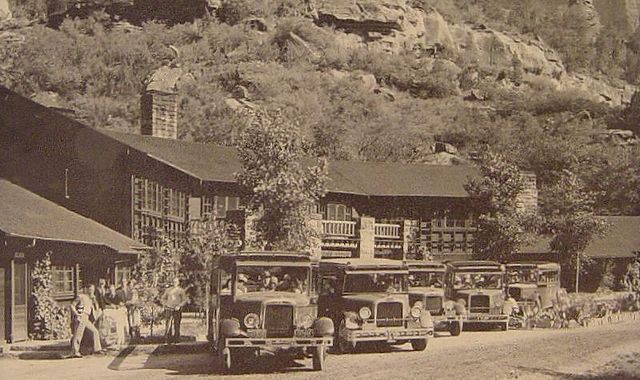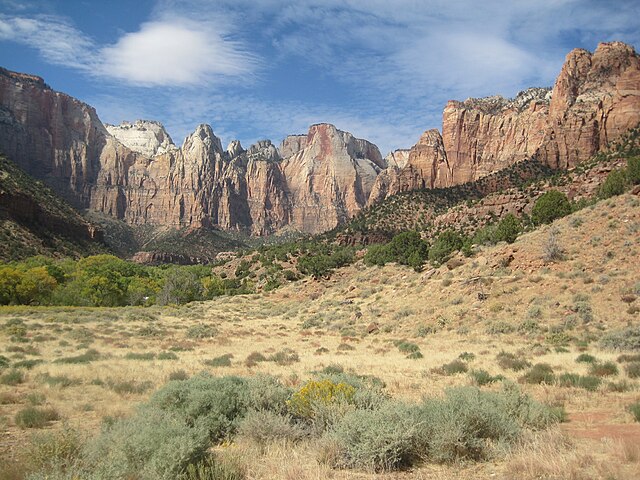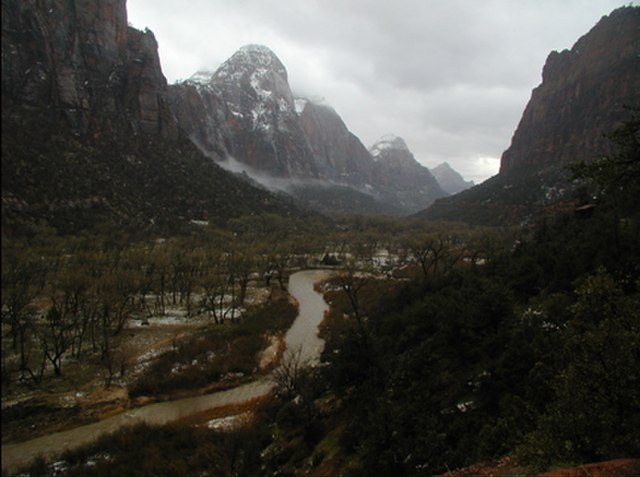Zion National Park
Zion National Park is an American national park located in southwestern Utah near the town of Springdale. A prominent feature of the 229-square-mile (590 km2) park is Zion Canyon, which is 15 miles (24 km) long and up to 2,640 ft (800 m) deep. The canyon walls are reddish and tan-colored Navajo Sandstone eroded by the North Fork of the Virgin River. The lowest point in the park is 3,666 ft (1,117 m) at Coalpits Wash and the highest peak is 8,726 ft (2,660 m) at Horse Ranch Mountain. Located at the junction of the Colorado Plateau, Great Basin, and Mojave Desert regions, the park has a unique geography and a variety of life zones that allow for unusual plant and animal diversity. Numerous plant species as well as 289 species of birds, 75 mammals (including 19 species of bat), and 32 reptiles inhabit the park's four life zones: desert, riparian, woodland, and coniferous forest. Zion National Park includes mountains, canyons, buttes, mesas, monoliths, rivers, slot canyons, and natural arches.
Human habitation of the area started about 8,000 years ago with small family groups of Native Americans, one of which was the semi-nomadic Basketmaker Anasazi (c. 300 CE). Subsequently, the Virgin Anasazi culture (c. 500) and the Parowan Fremont group developed as the Basketmakers settled in permanent communities. Both groups moved away by 1300 and were replaced by the Parrusits and several other Southern Paiute subtribes. Mormons came into the area in 1858 and settled there in the early 1860s. In 1909, President William Howard Taft named the area Mukuntuweap National Monument in order to protect the canyon. In 1918, the acting director of the newly created National Park Service, Horace Albright, drafted a proposal to enlarge the existing monument and change the park's name to Zion National Monument, Zion being a term used by the Mormons. According to historian Hal Rothman: "The name change played to a prevalent bias of the time. Many believed that Spanish and Indian names would deter visitors who, if they could not pronounce the name of a place, might not bother to visit it. The new name, Zion, had greater appeal to an ethnocentric audience." On November 19, 1919, Congress redesignated the monument as Zion National Park, and the act was signed by President Woodrow Wilson. The Kolob section was proclaimed a separate Zion National Monument in 1937, but was incorporated into the national park in 1956.The geology of the Zion and Kolob canyons area includes nine formations that together represent 150 million years of mostly Mesozoic-aged sedimentation. At various periods in that time warm, shallow seas, streams, ponds and lakes, vast deserts, and dry near-shore environments covered the area. Uplift associated with the creation of the Colorado Plateau lifted the region 10,000 feet (3,000 m) starting 13 million years ago.
- 1 Park purpose
-
2
Geography
- 2.1 Climate
- 3 History
- 4 Geology
- 5 Biology
- 6 Activities
- 7 See also
- 8 References
- 9 Bibliography
- 10 Further reading
- 11 External links
Links
Images Gallery
-

-

-
 The Three Patriarchs in Zion Canyon are made of Navajo Sandstone
The Three Patriarchs in Zion Canyon are made of Navajo Sandstone
-

-

-
 A ranch near the mouth of Zion Canyon (c. 1910s)
A ranch near the mouth of Zion Canyon (c. 1910s)
-

-

-

-

-

-

-

-

-

-

-

-

-

-
 Taylor Creek with Horse Ranch Mountain in background. Desert, riparian, woodland, and coniferous forest habitats are all visible.
Taylor Creek with Horse Ranch Mountain in background. Desert, riparian, woodland, and coniferous forest habitats are all visible.
-

-
-

-

-

-

-

-

-

-
 Towers of the Virgin: The Sundial (left), The Witch Head, Broken Tooth, Rotten Tooth, Altar of Sacrifice
Towers of the Virgin: The Sundial (left), The Witch Head, Broken Tooth, Rotten Tooth, Altar of Sacrifice
-
 Court of the Patriarchs, by Ansel Adams (1933)
Court of the Patriarchs, by Ansel Adams (1933)
-
 Kaun huts were used by Southern Paiute
Kaun huts were used by Southern Paiute
-
 Painting of Zion Canyon by Frederick S. Dellenbaugh (1903)
Painting of Zion Canyon by Frederick S. Dellenbaugh (1903)
-
 1938 poster of Zion National Park
1938 poster of Zion National Park
-
 The Altar of Sacrifice (center) with reddish, blood-like streaks
The Altar of Sacrifice (center) with reddish, blood-like streaks
-
 Zion shuttle bus stops are marked with numbers
Zion shuttle bus stops are marked with numbers
-
 The Kolob Canyons are a set of finger canyons cut into the Kolob Plateau. Timber Top Mountain to right.
The Kolob Canyons are a set of finger canyons cut into the Kolob Plateau. Timber Top Mountain to right.
-

-
 Desert bighorn sheep are often visible near the roadway in the park.
Desert bighorn sheep are often visible near the roadway in the park.
-
The Subway, a slot canyon within the Kolob Terrace section
-
Zion Lodge accommodations
-

-

-

-

-

-

-

-

-

-

-

-

-

-

-

-

-
-

-

-

-

-

-

-

-

-

-

-

-

-

-

-

-

-

-

-
-
-

-

-
-

-

-

-

-

-

-

-

-

-

-

-

-

-

-

-

-

-

-

-

-

-

-

-

-

-

-

-

-

-

-

-

-

-

-

-

-

-

-

-

-

-

-

-

-

-

-

-

-

-

-

-

Comments
-
Such a gorgeous place. If you plan to be there all day make sure you are prepared with enough food and water. Have the right shoes on and bring bandaids in case you start to get blisters. Narrows was very cool but dangerous when walking in the water around rocks. If you have bad ankles I don’t suggest it. Angels landing is a bit scary but worth the climb. This past week while we were in the area the park had two flash floods so be careful this time of year. They do close down several trails if it happens but you don’t want to be stuck out on a trail that gets flooded. Lots of friendly wild life to see. They run a free shuttle bus in and outside the park to help you get around which was nice but masks are required to ride on the shuttle. Not pet friendly because of the risky trails. Dogs aren’t allowed on the shuttle and can only go on one trail.
3 weeks ago -
This park has so much to see. The shuttle system was great, you have to wear masks on the shuttle) and our drivers were entertaining as well as informative. We couldn't do the Narrows hike due to flash for food warnings, so I'll have to go back. Don't go in July or August, if you can help it. It was WAAAAYYY too hot.
3 weeks ago -
What an awesome place. My greatest worry for this place is that since the COVID Pandemic, people have gone out to see these national treasures. The don't know how to respect the natural landscape and have destroyed and vandalized these places like they are some random building. The difference is nature isn't some canvas that can be repainted or repaired. I hope everyone can visit, just please take only photos and leave only footsteps.
5 days ago -
The water in this area tastes so good, it's sort of sweet. I made my tea with it and it tastes like heaven. What a stunningly beautiful place! It's probably even nicer in the winter when the snow covers the red peaks. Going through the tunnels is part of the fun, as we got to catch a quick glimpse of the different rock formations at every window before driving into the darkness again.
a week ago -
Zion holds its own against the great National parks! This place is one beautiful view/experience after another. Will definitely be back with future generations😀
a day ago -
One of the best national parks! Tons to see and do. The very best range in scenery from peaks to valleys. I could spend years exploring this park and never tire!. Even if youre not an expert hiker there are scenic and fun trails for you!
a week ago -
In terms of scope and grandeur, you'd be hard pressed to beat Zion. A glorious view no matter where you look. Sights were almost all surprisingly accessible.
2 days ago -
I absolutely loved Zion National Park and I recommend coming here 10/10. The trails and the whole park was amazing and had insane views. The trails built were also amazing. There are easy trails for the family and hard trails for hikers wanting to push their limits. Angel’s Landing and the Narrows are a must visit and one of the best trails to hike for some amazing views.
2 months ago




































































































































